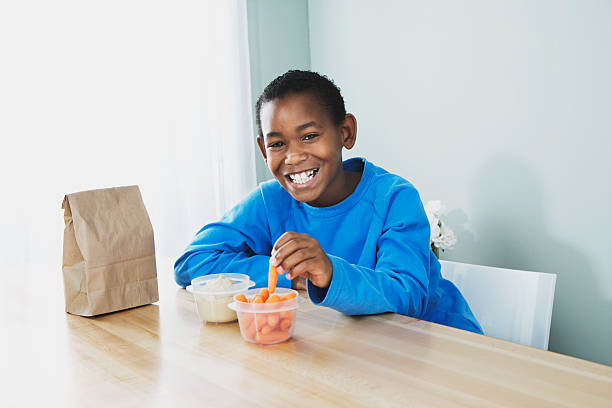
The biggest shortfall in most Americans' diets isn't vitamins or minerals. It's fiber. Experts say adult women should get 25 grams a day while men should get 38 grams. Yet we average a paltry 15 grams.
Our kids aren't doing any better. The American Heart Association (AHA) recommends that children ages 1 to 3 get at least 19 grams of fiber a day, and children ages 4 to 8 get 25 grams. The AHA says girls ages 9 to 18 require a minimum of 26 grams, and boys in the same age group should get 31 to 38 grams. Most children's diets don't provide nearly what they need.
Why worry? Because fiber has so many health benefits. High-fiber foods fill tummies up on fewer calories, so eating plenty of them is a key to maintaining a healthy weight. Fiber has been shown to lower bloodstream cholesterol levels and reduce heart attack danger. (These aren't big threats to a 6-year-old, sure, but excellent eating habits now can set your child up for a lifetime of good health.) It also appears to protect against type 2 diabetes, which is a growing problem among American children, as well as certain cancers. And in the category of less scary but quite uncomfortable conditions, fiber relieves constipation.
The bottom line: One of the best things you can do to help your child thrive is to increase the amount of fiber he or she consumes. (There's even a bonus: His or her health will benefit from the many other important nutrients that most fiber-rich foods have.) Begin slowly, nutritionists say, since it takes time for the digestive system to adapt to extra roughage. Too much too quickly can cause gas and bloating. Also encourage your child to drink more fluids, especially water.
Here's how the experts suggest increasing the amount of fiber in your child's diet:
Serve more fruits and vegetables.
Foods that come from plants, including fruits, vegetables, legumes, and whole grains, are the only sources of dietary fiber. Experts recommend aiming for at least 2 to 5 cups of fruits and vegetables a day. All produce isn't equally rich in fiber, though. Some of the standouts are artichokes, avocados, dried fruits, okra (not exactly a favorite of most kids), baked potatoes with the skin, pears, and carrots. Concentrate on the ones your child likes.
RELATED: Fill in the Fiber Gap for Better Diabetes Control
Avoid peeling produce.
The skin and membranes of apples, pears, potatoes, and many other fruits and veggies are where most of the fiber is, so resist your child's entreaties to peel things -- unless he or she really won't eat them otherwise. Just be sure to rinse produce thoroughly before serving. If you're concerned about pesticide residue and can afford organic produce, that's a fine option (but you should still rinse it well, as many people may have touched it since it left the tree or bush, and it may not be totally pesticide-free).
Serve vegetables raw or lightly cooked.
Many kids prefer veggies when they're crunchy. Serve your child's favorites -- carrots, celery, cauliflower, broccoli -- alongside salsa or low-fat salad dressing for dipping. When cooking veggies, it's best to microwave them in a small amount of water or steam them briefly so they retain most of their nutrients. Nevertheless, if your child will eat their broccoli only if it's mushy, then you know what to do: Make it mushy. He or she may gradually accept lesser degrees of mush. If you want to boost your child's enthusiasm about vegetables in general, make it a family project to cultivate a veggie garden. They'll be excited to see the snow peas he grew arrayed on his dinner plate.
Choose whole-grain cereals and breads.
Whole grains contain significantly more fiber than do processed grains. They're also good sources of vitamin E, B vitamins including folic acid, and other important nutrients. One of the quickest and healthful breakfasts you can fix for your child is a whole-grain cereal with reduced-fat milk; read labels to find a brand that delivers at least 5 grams of fiber per serving and isn't loaded with sugar. For even more fiber, vitamins, and minerals, top it off with raisins or sliced strawberries. When shopping for bread, don't rely on appearance: You may think that the browner the bread looks, the more whole grain it contains. But some brown loaves simply have added food coloring. Furthermore, a stamp reading "wheat bread" doesn't mean whole wheat and even a loaf labeled "whole wheat" may mix in more refined flour than you want. It's wise, therefore, to read the fine print, seeing whether ingredients high in the list include whole wheat flour, dark rye flour, rolled oats, oat bran, or wheat germ. Just one slice of a wholesome grainy bread from the health food store may contain as much as 4 grams of fiber.
RELATED: 7 Good Things That Will Happen To Your Body When You Eat More Fiber Daily
Pull a pasta switcheroo.
Whole grain pastas, available at most natural and many regular food stores, have a lot more fiber than the standard supermarket versions, so it's worth seeing if your child will eat them. When the spaghetti is swimming in their favorite tomato sauce, they may not even notice that you've substituted whole wheat for white. Whole wheat or spelt lasagna noodles are even harder to detect amidst the cheese, veggies, meat, and sauce. If your child does object to the chewy texture or stronger taste, look for new lines of pasta that are half whole grain and half refined, sold in many gourmet and health food stores. Or you could stick with standard pasta and simply use veggies and legumes to pump up the fiber in the recipe; try adding peas to macaroni and cheese or sneaking shredded carrots or diced zucchini into spaghetti sauce.
Add beans to the menu.
Beans and lentils are terrific sources of fiber (not to mention protein, B vitamins, iron, and other crucial nutrients). Even a quarter cup of kidney beans, for instance, provides a hefty dose of fiber. Dried lentils cook up quickly, but dried beans usually require soaking followed by an hour or so of simmering. If you're too busy for that, just buy canned beans, opting for low-sodium versions when available or else emptying the can into a strainer and rinsing the beans off.
Try black bean chili or three-bean salad. Slip beans into your Tuesday-night casserole and Wednesday-night stew. Nutty-tasting garbanzo beans (also known as chickpeas) make a pretty good substitute for meat in pasta dishes. If your child likes falafel, you can roll mashed and spiced-up garbanzos into balls and bake them -- the results are much more healthful than the deep-fried falafel served at restaurants. Kids usually love baked beans, which make a great side dish; to keep the fat content low, buy a brand without added meat like franks or pork.
Choose high-fiber snacks.
Keep carrot sticks, celery sticks, fresh fruit, dried fruit, and popcorn handy for when your child gets hungry between meals. When he or she has to have a cookie, offer a fig bar, a raisin biscuit, or an oatmeal cookie. Look for whole-wheat crackers with no hydrogenated oils, and top them with crunchy peanut butter. If he or she likes pretzels, there are versions with added oat bran -- don't worry, they won't taste it!
Experiment with grains.
Venture beyond whole wheat: Oats, millet, buckwheat, barley, brown rice, bulgur, triticale, and amaranth are some of the fiber-rich options. For a warming breakfast, oatmeal's an obvious choice, but you can also make hot cereal by simmering buckwheat with a little amaranth (rich in calcium, iron, and complete protein); stir in chopped fruit and a dusting of brown sugar.
Tabbouleh (bulgur wheat mixed with parsley, mint, lemon juice, olive oil, onion, and tomatoes) is a wonderful side dish, but kids' taste buds aren't always ready for it, so try making a simple pilaf with bulgur. If your child doesn't care for brown rice, see if they'll go for a mixture of brown and white (to cook them together, start the brown kind first and add the white for the last 20 minutes). Millet is versatile: You can use it to make a hot cereal, a pilaf, a casserole, or a pudding. For a sweet fiber-ful dessert, mix millet with honey, a drop of vanilla extract, chopped dates, and yogurt.








